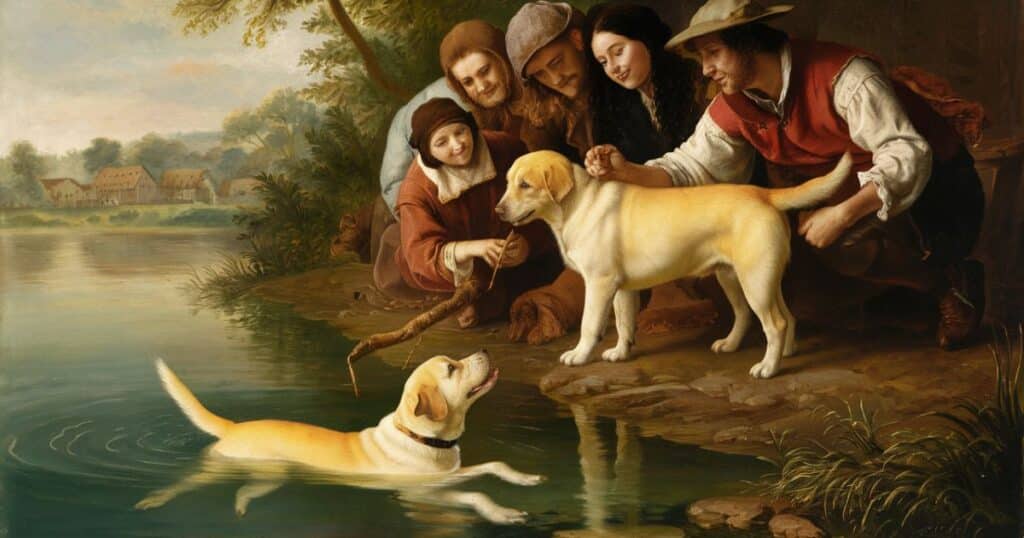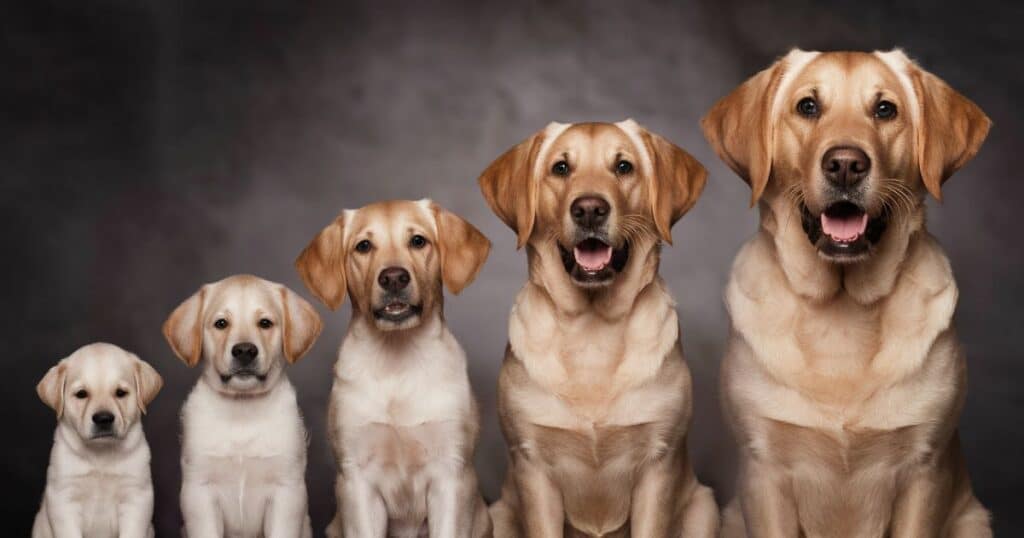Imagine a beloved family companion, a canine embodiment of unwavering loyalty and boundless affection, but with a unique twist. This Labrador sports a luxurious, fluffy coat that sets them apart from their counterparts. Meet the long-haired Labrador Retriever, a captivating variation of this beloved breed that has stolen the hearts of dog lovers worldwide. Long-haired Labrador Retrievers are really cool dogs.
They look like regular Labs but are extra fluffy and cuddly. Their fur is super soft and makes them seem like big teddy bears. Unlike other Labs, their coats are long and woolly. This makes them stand out in a fun way. Long-haired Labs have the same friendly personalities as other Labradors. They love people and get really excited to play and spend time with their families. Getting to know all about these one-of-a-kind Lab Retrievers is going to be an awesome adventure!
Breed Overview
The beloved Labrador Retriever, affectionately known as Labrador retrievers, is one of the most popular dog breeds worldwide. These friendly canines are renowned for their intelligence, obedience, and unwavering loyalty, making them exceptional companions and household pets. However, within this esteemed breed type, a unique canine variety has emerged the long-haired or fluffy Labrador.
While the traditional purebred Labrador is characterized by a short, dense coat, the long-haired or fluffy variant boasts a lush, wavy coat that sets them apart from their pedigree pup counterparts. These swimming canines, also known as aquatic pups or water-loving breeds, have captured the hearts of many with their adorable, fluffy appearance.
Labrador Retriever Characteristics
Before delving into the specifics of long-haired Labradors, let’s first explore the general characteristics of the Labrador Retriever breed:
- Size: Medium to large breed, with males typically weighing between 65-80 pounds and females ranging from 55-70 pounds.
- Coat: The standard Labrador coat is short, dense, and weather-resistant, making them well-suited for outdoor activities.
- Colors: Labradors come in three main colors: black, chocolate, and yellow (ranging from pale cream to golden coated and buttery shades).
- Temperament: Known for their friendly, outgoing, and gentle nature, Labradors make excellent family pets and are highly trainable.
- Energy Level: Lively pups and high-energy breeds, Labradors require ample exercise and mental stimulation to thrive.
- Roles: Originally bred as sporting partners, fowling buddies, and gun dog buddies, Labradors excel in various disciplines, including hunting, obedience, agility, and therapy work.
ALSO READ: White Labrador Retriever Dog Breed: Comprehensive Guide To Facts, Origin & History In 2024
The Earliest Records of the Labrador Retriever in History

The origins of the Labrador Retriever can be traced back to the island of Newfoundland, where they were originally bred by local fishermen to assist in water retrieval tasks. These hardy water dogs possessed an innate love for swimming and exceptional retrieving abilities, making them invaluable companions in the harsh maritime environment.
Historical accounts suggest that the Labrador’s ancestors were a mix of various retriever dogs and sporting dogs brought to Newfoundland by European settlers. Over time, these progenitor breeds and forebear canines were selectively bred to create the heritage lineage and original bloodlines that would eventually become the modern Labrador Retriever.
How Labrador Retrievers Gained Popularity
While the Labrador Retriever’s roots can be traced back to Newfoundland, it wasn’t until the breed was introduced to England in the early 20th century that its popularity truly began to soar. English noblemen and sportsmen quickly recognized the breed’s exceptional hunting and retrieving abilities, leading to their widespread adoption as hunting companions and family pets.
As word spread about these remarkable canines, the demand for Labrador Retrievers skyrocketed, and they soon became one of the most sought-after breed types worldwide. Their gentle, affectionate nature and adaptability to various environments further solidified their place as beloved household pets and companions.
Formal Recognition of the Labrador Retriever
As the Labrador Retriever’s popularity grew, it became necessary to establish formal breed standards and guidelines. In 1917, the breed was officially recognized by the Kennel Club in England, and in 1925, the American Kennel Club (AKC) followed suit, solidifying the breed’s place in the Sporting Group.
These breed guidelines and conformation rules outline the official specifications for the ideal Labrador Retriever, including physical characteristics, temperament, and overall appearance. Adherence to these standards is crucial for show quality and pedigree registration, ensuring that purebred and registered lineage Labradors maintain their pure bloodline and distinct breed identity.
Labrador Retriever Puppy Facts
As one of the most popular breed types, Labrador Retriever litters are highly anticipated events. Here are some fascinating facts about Labrador puppies:
- Litter Size: Labrador litters typically range from 5 to 10 puppies, with an average of 7 to 8 pups per litter.
- Growth and Development: Labrador puppies undergo rapid growth and development in their first year, reaching their full adult size by approximately 12-14 months.
- Socialization: Early socialization and training are crucial for Labrador puppies to develop well-rounded personalities and good behavior.
- Coat Changes: Labrador puppy fur and juvenile coats may appear slightly longer and fluffier than their adult counterparts, with the final coat texture and length emerging around 6-12 months of age.
Who is the Best Human for a Labrador Retriever?
While Labradors are known for their adaptability and suitability for various living situations, certain factors should be considered when determining if a Labrador Retriever is the right fit:
- Active Lifestyle: Labradors thrive in homes where they can receive ample daily exercise, whether through walks, hikes, or playtime in a fenced yard.
- Family-Friendly: Their gentle and affectionate nature makes Labradors excellent family pets, especially for households with children.
- Training Commitment: Labradors are highly intelligent and require consistent training and mental stimulation to prevent boredom and unwanted behaviors.
- Outdoor Enthusiasts: As sporting partners and outdoorsy pals, Labradors excel in activities like hiking, swimming, and retrieving games, making them ideal for active individuals or families.
Getting a Labrador Retriever Puppy
Adopting Labrador Retriever Puppies
One option for obtaining a Labrador Retriever puppy is through adoption from a reputable rescue organization or shelter. This not only provides a loving home for a deserving pup but also helps reduce the number of dogs in need of adoption.
When adopting a Labrador Retriever puppy, it’s essential to gather as much information as possible about the pup’s background, health history, and temperament. Reputable rescue organizations often conduct thorough evaluations and can provide valuable insights to help match you with the right puppy.
Finding a Labrador Retriever Breeder
If you prefer to purchase a Labrador Retriever puppy from a breeder, it’s crucial to research and select a responsible and ethical breeder. Reputable breeders prioritize the health and well-being of their dogs, adhering to best practices in breeding, socialization, and early puppy care.
When searching for a breeder, look for the following:
- Health Certifications: Responsible breeders should provide documentation of health clearances for genetic conditions common in the breed.
- Socialization Practices: Puppies should be raised in a nurturing environment and properly socialized from an early age.
- Breeding Ethics: Ethical breeders breed for the betterment of the breed, not solely for profit, and follow guidelines set by breed clubs and organizations.
- Contracts and Guarantees: Reputable breeders typically provide contracts outlining their policies, guarantees, and expectations for new puppy owners.
The cost of a Labrador Retriever puppy from a reputable breeder can vary depending on your location and the breeder’s reputation, but expect to pay anywhere from $800 to $1,500 or more.
Labrador Retriever Puppy Resources
As a new or prospective Labrador Retriever owner, it’s essential to educate yourself on the breed’s specific needs and requirements. Here are some helpful resources to guide you:
- Books:
- “The Labrador Retriever Handbook” by D. Caroline Coile, Ph.D.
- “Labrador Retrievers for Dummies” by Eve Adamson and Gary Adamson
- “The Ultimate Labrador Retriever” by Sharon Mascall-
- Websites and Online Communities:
- The Labrador Retriever Club, Inc. (https://thelabradorclub.com/)
- Labrador Retriever Forum (https://www.labradorretrieverforum.com/)
- Labrador Retriever Rescue Organizations (https://labrescue.org/)
- Training Guides and Tips:
- “The Labrador Retriever: The Complete Retriever Training Guide” by Richard A. Wolters
- “Labrador Retrievers: How to Train Your Labrador Retriever” by Kimberly Rohas
- Local Clubs and Events:
- Check for local Labrador Retriever clubs or breed-specific events in your area to connect with fellow owners and breeders.
Similar Breeds to the Labrador Retriever
While Labradors are a beloved breed, there are other retriever and sporting dog breeds that share similar characteristics and may suit your lifestyle. Some options to consider include:
- Golden Retriever: Known for their friendly dispositions and golden coats, Golden Retrievers are intelligent and make excellent family companions.
- Flat-Coated Retriever: A lesser-known breed, Flat-Coated Retrievers are energetic, intelligent, and excel in various dog sports.
- Chesapeake Bay Retriever: Bred for waterfowl hunting, Chesapeake Bay Retrievers are hardy, loyal, and thrive in outdoor activities.
- Nova Scotia Duck Tolling Retriever: With their unique fox-like appearance and high energy levels, Tollers are versatile hunting companions and active family pets.
While these breeds share some similarities with Labradors, it’s essential to research their specific traits, grooming needs, and temperaments to find the best fit for your lifestyle.
The Genetics Behind Long-Haired Labradors
To better understand the origin of the long-haired or fluffy coat in Labradors, it’s essential to explore the genetics behind this unique trait. While the standard Labrador Retriever breed is known for its short, dense coat, the long-haired variation is the result of a recessive gene variant or hereditary characteristic within the breed’s genetic makeup.
This recessive trait is believed to be caused by a specific DNA sequence or gene variant that affects the length and texture of the dog’s coat. When two Labradors carrying this recessive gene are bred together, a portion of their offspring may inherit the long-haired or fluffy coat.
It’s important to note that the long-haired trait is not a result of cross-breeding or mixed ancestry; these fluffy Labradors are purebred dogs with a registered lineage and full breed status. However, due to the rarity of this trait and its deviation from the traditional breed standard, long-haired Labradors may not be recognized by all major kennel clubs or organizations.
To ensure the health and well-being of long-haired Labrador puppies, responsible breeders often employ genetic analysis and parentage verification techniques. These methods, such as breed identification and molecular diagnostics, help breeders confirm the ancestry profiling of their breeding stock and make informed decisions when propagating the long-haired trait.
ALSO READ THIS POST: Red Fox Lab: The Foxy Canine Companion You Need In 2024
The Long-Haired Labrador Coat: From Puppy to Adult

One of the most endearing aspects of long-haired Labradors is their adorable, fluffy appearance, especially during their puppy and juvenile stages. However, it’s important to understand that the coat of a long-haired Labrador puppy may undergo changes as the dog matures.
During the early stages of life, long-haired Labrador puppies often sport a soft, downy coat that can appear even fluffier and longer than their adult counterparts. This puppy fur is typically more delicate and may be prone to matting or tangling without proper grooming and care.
As the puppy grows and enters its shedding phase, their juvenile coat will gradually be replaced by their adult coat. This transition typically occurs between 6 and 12 months of age, during which time the fur texture and hair length may change.
Adult long-haired Labradors typically have a longer, wavy, or slightly curly coat compared to their short-haired counterparts. However, the exact shedding pattern and coat length can vary among individual dogs, as it is a breed characteristic and physical trait influenced by genetics.
It’s essential to note that while the long-haired trait is a recognized variation within the breed, it is still subject to the overall breed guidelines and confirmation rules set forth by kennel clubs and breed organizations. Responsible breeders strive to maintain the health, temperament, and essential characteristics of the Labrador Retriever breed while selectively breeding for the long-haired coat.
Top 5 Unique Facts About Long-Haired Labrador Retrievers
Now, let’s delve into the fascinating world of long-haired or fluffy Labradors, a unique variation of the beloved breed:
1. They Love Water
Like their standard counterparts, long-haired Labradors possess an innate love for water and swimming. Their historical roots as water retrievers and aquatic pups have instilled in them a natural affinity for aquatic environments, making them excellent doggy paddlers.
2. They Come in Three Main Colors
Just like their short-haired counterparts, long-haired Labradors can be found in the three traditional colors: black, chocolate, and yellow. However, their longer coats often give them a slightly different appearance, with a more “fluffy” or “woolly” look.
3. They Are Versatile
While not recognized by all major kennel clubs, long-haired Labradors are just as versatile as their standard counterparts. They excel in various roles, including hunting, obedience, agility, and therapy work, making them ideal sporting partners and family pets.
4. They Are Energetic
Like all Labradors, long-haired or fluffy variants are high-energy active canines that require plenty of exercise and mental stimulation. Their spirited doggo personalities make them excellent companions for active individuals or families.
5. They Are Social
The friendly and outgoing temperament that Labradors are known for is also present in their long-haired counterparts. These furry friends thrive on human interaction and make wonderful additions to social households.
Does the Long-Haired Labrador Retriever Make a Good Pet?
The long-haired or fluffy Labrador Retriever can make an excellent pet for the right owner. Their affectionate personalities, intelligence, and versatility make them well-suited for various living situations, from active families to experienced dog owners.
However, it’s essential to consider the additional grooming needs associated with their longer coats. Regular brushing, trimming, and potential professional grooming may be required to maintain their coat and prevent excessive shedding or matting.
Additionally, while their unique appearance may be appealing, it’s crucial to understand that the long-haired trait is a genetic anomaly caused by a recessive gene. This means that responsible breeders must carefully manage breeding programs to ensure the health and well-being of the puppies and maintain the breed’s overall integrity.
Prospective owners should also be prepared to educate themselves and others about the long-haired Labrador variation, as it may be mistaken for a mixed breed or other similar appearance by those unfamiliar with this breed type.
Long-Haired Labradors as Service and Working Dogs

Like their short-haired counterparts, long-haired Labradors possess the drive, focus, and eagerness to please which are essential qualities for service and working dogs. With proper training and socialization, these remarkable canines can excel in a wide range of specialized roles, including:
- Guide Dogs: Their gentle nature, adaptability, and eagerness to work make long-haired Labradors well-suited for guiding individuals with visual impairments, providing them with increased independence and mobility.
- Therapy Dogs: The calming presence and affectionate personalities of long-haired Labradors can bring comfort and joy to individuals in hospitals, nursing homes, schools, and other therapeutic settings.
- Detection Dogs: With their exceptional sense of smell and trainability, long-haired Labradors can be trained to detect a variety of substances, including explosives, narcotics, and even certain medical conditions, making them invaluable assets in law enforcement and security roles.
- Search and Rescue Dogs: Their endurance, agility, and ability to work in challenging environments make long-haired Labradors valuable members of search and rescue teams, helping to locate missing persons or survivors in disaster areas.
- Assistance Dogs: Whether providing physical support, retrieving objects, or performing other tasks, long-haired Labradors can be trained as assistance dogs to aid individuals with disabilities, enhancing their independence and quality of life.
the long-haired trait may not be recognized by all breed organizations or kennel clubs, many service and working dog organizations prioritize the temperament, trainability, and overall suitability of the dog rather than strictly adhering to breed standards.
Summing Up
The long-haired or fluffy Labrador Retriever is a fascinating variation of this beloved breed, offering a unique and endearing appearance while retaining the intelligence, affection, and versatility that Labradors are known for.
Whether you’re considering adding a long-haired Labrador to your family or simply appreciating their unique charm, it’s essential to understand their history, characteristics, and specific needs. By educating yourself and working with reputable breeders or rescue organizations, you can ensure a rewarding and fulfilling experience with these furry friends.
Remember, responsible pet ownership is key, and prioritizing the well-being and proper care of these domesticated animals should be at the forefront of any decision to welcome a long-haired Labrador into your life.
As you embark on your journey with these aquatic pups and water-loving breeds, embrace their lively and spirited personalities, cherish their companionship, and enjoy the many adventures that await you and your fluffy Labrador.
RELATED ARTICLE; The Unique Dudley Labrador: A Comprehensive Guide
FAQ’s
What is a fluffy Labrador called?
A fluffy Labrador is commonly referred to as a “long-haired Labrador Retriever”. This term describes the longer, woollier coat that sets them apart from the standard short-haired Labradors. Some also affectionately call them “fluffy Labs” or “wooly Labs” due to their distinctive fuzzy appearance.
Can lab puppies be fluffy?
Yes, Labrador Retriever puppies can be born with a fluffy, longer coat. The long-haired trait is present from birth and is not a result of a puppy coat. Fluffy Labrador puppies often appear even more adorably fuzzy in their early stages.
What is the fluffy Labrador gene?
The fluffy coat of long-haired Labradors is caused by a recessive gene variant. This recessive trait results in a longer, wavier, or slightly curly coat texture. When two Labradors carrying this recessive gene are bred, a portion of the offspring will inherit the fluffy coat.
Are there long-haired labs?
Yes, long-haired Labradors do exist as a recognized variation within the breed. While not accepted by all major kennel clubs, some organizations acknowledge this unique trait. Long-haired Labradors are purebred dogs with a full Labrador Retriever lineage, just with a distinctively longer coat.

Davin Connor is an experienced author with 3 years in pets writing. Known for concise, informative content, he shares expertise on pet care, behavior, and health through his engaging articles.






